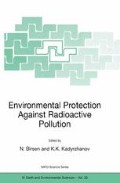Abstract
In the paper there is discussed a possible radiation effect a combat application of armor - piercing ammunitions with a “depleted uranium” (DU) in Iraqian and Yugoslavian conflicts. The objective analysis of real data has shown, that an application of ammunitions with “DU” during the combat actions in Yugoslavia could not lead to a noticeable additional influence onto natural environment and health of military men and population on the background of the common detriment because of an application of weapon. However, the experience of local wars in Kuvate and Yugoslavia testifies, that an application of contemporary (modern).
Access this chapter
Tax calculation will be finalised at checkout
Purchases are for personal use only
Preview
Unable to display preview. Download preview PDF.
References
Bhat R. (2000) Analysis of Transuranics and Other Contaminants in Depleted Uranium Armor. AMSAM-TMD-SB, 19 January.
Radiation Safety Standards (NRB-99), Moscow, 1999 (In Russian)
Standards for Protection Against Radiation. 10 CFR 20. 1991.
EPA.-Rule on Radionuclides in Drinking Water, 65 FR 76707, 7 Dec 2000.
ATSDR (Agency for Toxic Substances and Disease Registry). Update. Public Health Service, U.S. Department of Health and Human Services, Atlanta, Ga.,1997.
Jacob, P., Pröhl, G., Schneider, K., Voß, J.-U.: Machbarkeitsstudie zur Verknüpfung der Bewertung radiologischer und chemisch-toxischer Wirkungen von Altlasten, Texte 43/97, Berlin, 1997.
Depleted Uranium in the Gulf (II). Environmental Exposure Report. US Department of Defense. December 13, 2000.
Transuranics elements in the environment, Energoatomizdat, M., 1985.
Health and Environmental Consequences of Depleted Uranium Use in the U.S. Army: Technical Report. Army Environmental Police Institute, Atlanta, Georgia, 1995.
The potential effects on human health and the environment (UNEP/UNCHS Balkans Task Force, BTF), Okt. 1999.
Author information
Authors and Affiliations
Editor information
Editors and Affiliations
Rights and permissions
Copyright information
© 2003 Springer Science+Business Media Dordrecht
About this paper
Cite this paper
Vetrov, V.A., Pavlovsky, O.A. (2003). Evaluation of Environmental and Health Consequences of Depleted Uranium Armor use in Yugoslavia. In: Birsen, N., Kadyrzhanov, K.K. (eds) Environmental Protection Against Radioactive Pollution. NATO Science Series, vol 33. Springer, Dordrecht. https://doi.org/10.1007/978-94-007-0975-1_21
Download citation
DOI: https://doi.org/10.1007/978-94-007-0975-1_21
Publisher Name: Springer, Dordrecht
Print ISBN: 978-1-4020-1790-2
Online ISBN: 978-94-007-0975-1
eBook Packages: Springer Book Archive

